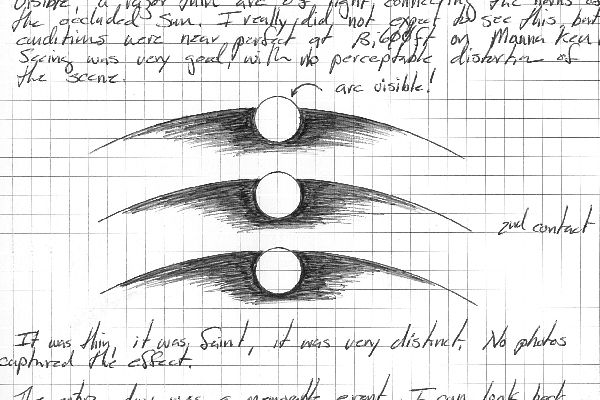Black drop effect? Bah! I observed a beautiful aureole effect in the minutes leading up to second contact.
The famous black drop effect is seen when atmospheric distortion of the image is quite bad. The effect plagued the early observers attempting to do transit timings. The effect is not seen when the atmosphere allows sharp views of the transit.
Instead, if the seeing is truly good, it is possible to see something far more rare, the aureole of Venus. This is a faint ring of light that has been refracted and scattered through the atmosphere of the planet.
I had not expected to see this, the appearance of the arc of light a complete surprise. But there it was… Very thin, quite faint, a sharp arc of light completing the disk of Venus. The view was steady, with nearly perfect seeing the arc was visible continuously.
Analyzing the observation afterwards I realize it was two elements that allowed me to see the aureole, the excellent seeing offered by the summit of Mauna Kea and good equipment. I was looking through my TeleVue 76mm telescope, using an 8mm Radian eyepiece and a Baader solar film filter. Very good equipment indeed, the optical performance of the system was not going to be a problem.
In the confusion and effort of running the Keck Observatory web stream, I was so glad I managed to free up the few minutes necessary to properly observe second contact. The sight was one of the most beautiful and sublime of any I have witnessed through an eyepiece in my many years of looking through a telescope.
I have been through my photos, nothing captured the faint arc of the aureole, no matter how I stretch the exposure. The best I can do is to record a few drawings in my observing notebook, a poor substitute for the beauty of the real thing…



Hi Andrew- Nice post, great transit! I got the opposite of you regarding the aureole – had my camera shooting through another Ceragioli scope, a 7″ F/12, taking a pic every 20 seconds. I got in an extra one or two frames between 1st and 2nd contact with twice the exposure (2000th rather than 4000th sec), and it was on one of those that the stretched image shows the arc. I didn’t have any other higher power scope to look thru other than the 20X120 binoculars, where it wasn’t visible… The blog (www.theketelsens.blogspot.com) has the stretched image… Great job! So you used Roger’s scope to webcast the transit? Did you tell him? He is in usually cloudy Vancouver, so would have loved to watch it through his own scope remotely! -Dean